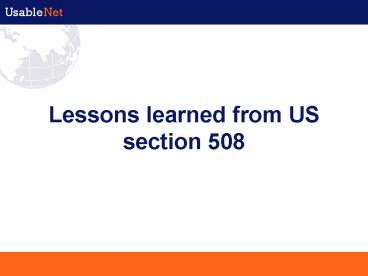Lessons learned from US section 508 - PowerPoint PPT Presentation
1 / 16
Title:
Lessons learned from US section 508
Description:
On 8 December 1999, the eEurope initiative was launched by the European ... Training accessibility training in Milan on July 7th with Professore Giorgio Brajnik. ... – PowerPoint PPT presentation
Number of Views:49
Avg rating:3.0/5.0
Title: Lessons learned from US section 508
1
Lessons learned from US section 508
2
UsableNet Presenter Emily DixonFormer US
Product Marketing Manager Director of European
Developmentemily_at_usablenet.com
3
Accessibility in Europe
- On 8 December 1999, the eEurope initiative was
launched by the European Commission (EC) to
accelerate Europes transformation into an
Information Society. - With the theme of an information society for
all, it endeavors to bring the benefits of this
society to all Europeans, including those with
disabilities. - .2003 has been designated the European Year of
Disabled People (EYDP) by the European
Commission.
4
Accessibility in Italy
- 5 degli italiani sono colpiti da disabilita
- ''Abbattiamo la barriere virtuali che non
consentono ai disabili una migliore qualita'
della vita ed una piena integrazione sociale''.
Lucio Stanca - Proposta di Legge Primo obiettivo del
provvedimento è rendere accessibili i siti
internet e comunque tutti i rapporti
telematici tra cittadini e Pubblica
Amministrazione.
5
US legislation What is Section 508?
- Section 508 of the U.S. Federal Rehabilitation
Act ensures people with disabilities access to
goods and services provided by the federal
government. - The 16 paragraphs of 1194.22 of Section 508 is
based largely on WAI (Web Accessibility
Initiative) guidelines from the W3C (World Wide
Web Consortium). - On June 25, 2001, accessibility requirements for
Federal electronic and information technology
took effect under Section 508 of the
Rehabilitation Act.
6
Who has to comply?
- Federal departments and agencies including the
U.S. Postal Service - Contractors providing services or products to
Federal agencies must provide Section 508
compliant deliverables.
7
US compliance with Section 508?
UsableNet
- UsableNet has worked with NASA, the Department of
Education, USDA, National Institute of Health,
Postal Service--in total over 100 US departments
to provide tools for testing, repair and
compliance with Section 508. - Two years later, many government websites are
still struggling to comply with section 508. - Those who confronted the problem quickly and
utilized tools for automating the process are far
ahead of the rest.
8
What is Web Accessibility?
- Accessibility is the ability of anyone, including
those who have disabilities to access content and
information on the Internet.
9
Why is Accessibility important?
- With the growth of the Internet as a critical
medium for communicating information and
providing services, it is important that this
information be accessible to everyone, including
people with disabilities.
10
The whole story
- As people age, most are eventually affected by a
disability. - Poor eyesight, arthritis and hearing loss are
common among older individuals. - According to the Trace Center, 75 of people over
the age of 65 are affected by a disability.
11
What can Europe learn from US section 508?
- The importance of standards with explicit
guidelines. - How to implement an accessibility policy.
Training and education, accountability, and
management. - The role of tools in the accessibility project.
12
Explicit Guidelines
- Often, legislation refers to the W3C WAI
guidelines. - US section 508 was pulled from W3C guidelines,
but states the requirements explicitly so that
there is no confusion should the W3C guidelines
change. - Focus on compliance should be on the standards
(law), so that organizations are not looking at
different assistive technologies for testing.
(i.e. a site that works on Jaws is not necessary
accessible to everyone)
13
The Process
- Establish an accessibility policy.
- Educate webmasters and developers on what
accessibility is and how to implement accessible
web design. - Execute and Enforce policy with website testing,
and retrofitting of existing sites. Create
internal accountability.
14
Retrofitting existing sites
- Test existing content according to accessibility
guidelines. - Create a plan for retrofitting content to comply
with accessibility guidelines. - Choose a tool to test and repair content to speed
the process up and save on development costs.
15
UsableNet tools for testing and repair
- LIFT for Dreamweaver in Italianworks inside the
Dreamweaver environment to test and fix content
quickly and easily. - LIFT Machinean enterprise solution for testing
live public and password protected websites. - (Used by IBM, NASA, and US universities. Winner
of Best New Technology Award from GCN.)
16
How UsableNet can help
- Free sample accessibility test on
www.usablenet.com. - Accessibility Trainingaccessibility training in
Milan on July 7th with Professore Giorgio
Brajnik. - Free initial Accessibility evaluation and Demo of
LIFT products. - For more information contact Emily_at_usablenet.com

